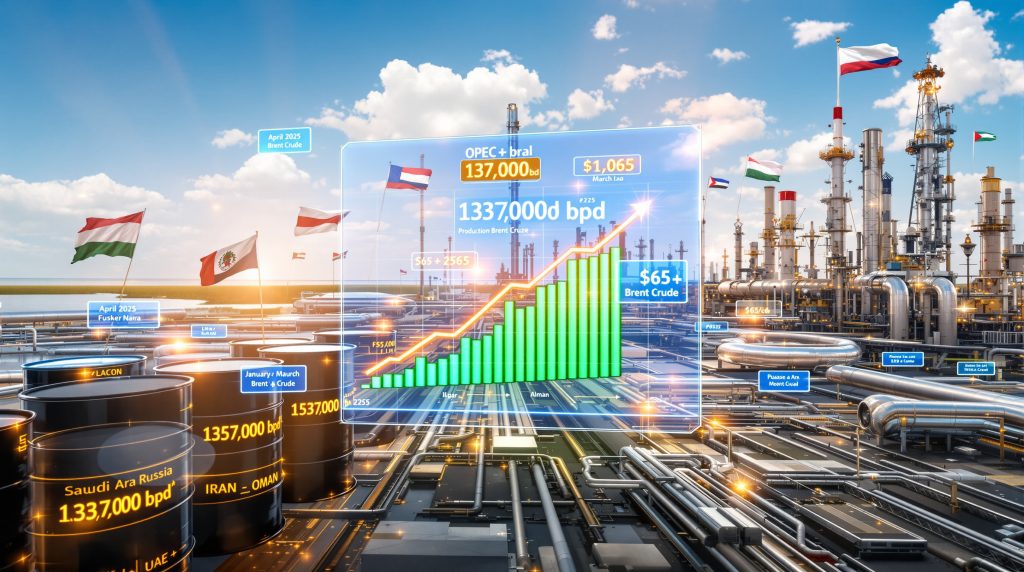Understanding OPEC+ Strategic Production Management
The Organization of the Petroleum Exporting Countries and its allies (OPEC+) represents one of the most influential energy cartels in global markets, comprising 13 OPEC member states and 10 non-OPEC allied producers. This coalition controls approximately 40 per cent of global crude oil production, making their strategic decisions critical to worldwide energy stability and pricing dynamics.
The recent announcement of an opec production pause beginning January 2026 marks a significant shift in the organisation's adaptive supply management approach. This strategic decision demonstrates OPEC+'s evolution from rigid production schedules to responsive market stewardship, reflecting real-time assessment of global economic conditions and inventory levels.
The December 2025 production increase of 137,000 barrels per day represents the ninth consecutive monthly increase authorised by eight core member nations. This measured approach contrasts sharply with the organisation's historical preference for larger quarterly adjustments, indicating a sophisticated understanding of market psychology and supply-demand dynamics.
OPEC+ has implemented what industry analysts term a "layered unwinding" strategy for production cut reversals. Rather than simultaneously removing all production restrictions, the organisation methodically reverses reduction commitments in distinct tranches. The initial 2.2 million barrel per day voluntary production cut implemented in late 2022 was unwound between April and September 2025, followed by commencement of a second 1.65 million barrel per day layer unwinding in October 2025.
What Does the OPEC+ Production Pause Mean for Global Markets?
The three-month production pause from January through March 2026 represents the first interruption in consecutive monthly production increases since the unwinding process began in April 2025. This strategic halt affects global market dynamics by prioritising stability over aggressive supply expansion during a period of heightened uncertainty.
Market Impact Analysis:
-
Supply Stability: The pause maintains current production levels rather than implementing cuts, providing price support without creating artificial scarcity
-
Seasonal Adjustment: Recognition of typical Q1 demand weakness allows markets to rebalance naturally during low-consumption periods
-
Policy Flexibility: Demonstrates OPEC+'s commitment to adaptive management based on real-time market conditions
-
Risk Management: Provides buffer time to assess geopolitical impacts, particularly regarding US sanctions on Russian producers
Current Brent crude futures trading around $65 per barrel as of November 2025 reflect market acceptance of this balanced approach. The price level represents recovery from multi-month lows following October sanctions announcements while avoiding the volatility associated with either aggressive production increases or sudden supply restrictions.
Furthermore, the organisation's characterisation of the pause as responding to "seasonality" and "expectations of weaker oil demand in the first quarter of 2026" signals integration of sophisticated demand analytics into supply planning. This data-driven approach represents a fundamental departure from purely supply-side considerations that historically dominated OPEC+ decision-making. However, recent oil price movements suggest markets remain cautious about broader geopolitical implications.
Which Countries Are Affected by the Production Pause?
The opec production pause specifically impacts eight core member nations that collectively represent approximately 27-28 million barrels per day of crude production capacity, or roughly 27 per cent of global crude output. This concentration demonstrates why OPEC+ decisions carry such profound market implications.
Saudi Arabia leads the group as the world's largest oil producer with crude production capacity of approximately 12-13 million barrels per day. The Kingdom maintains the largest proven oil reserves at 268 billion barrels and operates with spare production capacity estimated at 1-1.5 million barrels per day. Saudi Arabia's role as the dominant swing producer provides the enforcement mechanism for OPEC+ agreements through its willingness to adjust output to maintain market discipline.
Russia operates as the world's second-largest crude producer with production levels around 10.5 million barrels per day. However, the country faces newly implemented US sanctions targeting major producers Rosneft and Lukoil, creating significant production uncertainty. These sanctions, announced October 22, 2025, represent the most substantial restrictions on Russian crude capabilities since earlier 2024 measures, affecting the broader global trade impact of energy policies.
Iraq serves as OPEC's second-largest producer with crude production capacity of approximately 4.5-4.7 million barrels per day. The nation operates under constitutional requirements for parliamentary approval of long-term oil contracts, creating domestic political constraints on production decisions that must be balanced against OPEC+ commitments.
Regional Production Leaders:
| Country | Production Capacity (bpd) | Key Characteristics |
|---|---|---|
| United Arab Emirates | 2.9-3.0 million | Major refining and trading hub with downstream integration |
| Kuwait | 2.7-2.8 million | Traditional swing producer with regional geopolitical considerations |
| Kazakhstan | 1.6-1.7 million | Non-OPEC partner with Tengiz, Karachaganak, and Kashagan field production |
| Algeria | 1.0-1.1 million | North African producer with seventh-largest global proven reserves |
| Oman | 0.7-0.8 million | Non-OPEC partner facing natural field depletion in mature offshore fields |
The diverse geopolitical circumstances affecting each nation necessitate complex consensus-building mechanisms. From Russian sanctions exposure to Iraqi parliamentary requirements to Kuwaiti regional positioning, the eight-member core group must balance competing national interests while maintaining collective market influence.
How Do Market Conditions Influence OPEC+ Decisions?
OPEC+ decision-making incorporates sophisticated market condition assessment tools that extend far beyond traditional supply-demand calculations. The organisation's emphasis on maintaining "full flexibility" reflects recognition that rigid policy commitments can prove costly when market dynamics shift rapidly.
Critical Market Indicators:
-
Inventory Monitoring: Global crude oil stocks currently described as "low" relative to five-year averages, providing fundamental price support
-
Economic Growth Projections: International Monetary Fund forecasts of 3.1 per cent global GDP growth in 2025 and 3.2 per cent in 2026 suggest moderate expansion
-
Seasonal Demand Patterns: Historical Q1 demand typically runs 5-10 per cent below Q4 levels due to reduced winter heating and transportation demand
-
Geopolitical Risk Premiums: Current pricing reflects supply disruption risks from Middle East tensions and sanctions impacts
The organisation explicitly acknowledges that the production pause reflects uncertainty regarding Q1 2026 demand dynamics rather than concerns about current market conditions. This forward-looking risk management approach prioritises obtaining additional market data before committing to further production increases.
Consequently, global economic conditions characterised as "steady" by OPEC+ mask underlying divergence in growth expectations among major consuming regions. The United States, European Union, and China each face distinct economic challenges that could affect oil demand growth trajectories through 2026, with US oil production decline concerns adding another layer of complexity.
Market Psychology Insight: The timing of the OPEC production pause announcement immediately following US sanctions against Russian producers illustrates how geopolitical events trigger reassessment of market conditions rather than knee-jerk policy responses.
What Impact Do US Sanctions Have on Production Planning?
US sanctions targeting Russian oil producers Rosneft and Lukoil, announced October 22, 2025, create extraordinary production uncertainty affecting approximately 6.3-6.5 million barrels per day or roughly 60 per cent of Russian crude output. This represents the most significant restriction on Russian energy capabilities since the conflict began, according to the Financial Times.
Sanctions Implementation Mechanisms:
-
Vessel Restrictions: Prohibition of US-flagged and allied-nation vessels from transporting Russian crude
-
Financial Services Limitations: Restrictions on banking and insurance services supporting Russian energy operations
-
Technology Transfer Barriers: Limitations on equipment and technical services essential for production maintenance
-
Secondary Sanctions: Penalties for third-party entities facilitating sanctioned activities
Rosneft accounts for approximately 4.5 million barrels per day of crude production, representing 40-45 per cent of Russia's total output. Lukoil contributes approximately 1.8-2.0 million barrels per day, representing 15-20 per cent of Russian production. The combined impact creates unprecedented uncertainty regarding actual supply availability.
OPEC+ delegates acknowledge it remains "too early to gauge the sanctions' impact on physical supply," suggesting the production pause represents prudent preparation pending clarity on actual supply disruption magnitude. This assessment reflects industry recognition that sanctions' theoretical impact often diverges from operational reality due to workarounds and alternative export arrangements.
In addition, Brent crude futures rebounded approximately $5-8 per barrel in the days following the October 22 sanctions announcement, indicating market concern about potential supply tightness. However, the relatively modest price increase suggests traders expect limited immediate impact on physical crude availability, as evidenced by recent oil price rally analysis.
Historical Sanctions Effectiveness Analysis:
Previous sanctions regimes have demonstrated mixed effectiveness in reducing actual crude exports. Russia has historically developed alternative shipping networks, payment mechanisms, and trading relationships that partially offset sanctions impacts. The current pause allows OPEC+ to assess whether these adaptation mechanisms remain viable under enhanced restrictions.
How Has OPEC+ Production Evolved Since 2022?
OPEC+ production management since late 2022 demonstrates sophisticated strategic planning that balances market stability with member nation revenue requirements. The organisation implemented 3.66 million barrels per day in voluntary production cuts during the market uncertainty of late 2022, creating the foundation for current unwinding processes.
Production Evolution Timeline:
| Period | Action Taken | Volume Impact | Strategic Rationale |
|---|---|---|---|
| Late 2022 | Deep voluntary cuts implemented | -3.66 million bpd | Market stability during economic uncertainty |
| April 2025 | First unwinding layer begins | +2.2 million bpd target | Demand recovery assessment |
| September 2025 | First layer completion | +1.96 million bpd actual | Compensation adjustments included |
| October 2025 | Second layer unwinding starts | +1.65 million bpd target | Measured supply restoration |
The actual production increase of 1.96 million barrels per day between April and September 2025 fell short of the headline 2.2 million barrel per day target due to compensation mechanisms. Several of the eight core members required production credit adjustments for past overproduction relative to agreed quotas, demonstrating the organisation's commitment to compliance discipline.
Monthly increases of 137,000 barrels per day during October, November, and December 2025 represent a measured approach to the second unwinding layer. This gradual restoration contrasts with historical OPEC+ tendencies toward dramatic policy shifts, reflecting organisational learning regarding market disruption risks.
Production Compliance Mechanisms:
-
Secondary Source Monitoring: Independent verification of member nation output through multiple data sources
-
Compensation Adjustments: Credits and debits for nations exceeding or falling short of quotas
-
Enforcement Through Market Leadership: Saudi Arabia's willingness to adjust output maintains discipline
-
Regular Assessment Meetings: Scheduled reviews allow policy adjustments based on market evolution
What Are the Competing Market Forecasts?
Sharp disagreement between major forecasting organisations creates the uncertainty backdrop justifying OPEC+'s cautious production pause approach. The International Energy Agency (IEA) and OPEC offer fundamentally different assessments of supply-demand balance prospects through 2026.
IEA Perspective – Supply Surplus Concerns:
The International Energy Agency forecasts significant supply surplus conditions in Q4 2025 extending into 2026. This projection emphasises potential oversupply risks arising from:
-
Non-OPEC Production Growth: Continued expansion from US shale and other non-OPEC sources
-
Demand Growth Weakness: Economic headwinds constraining consumption expansion
-
Inventory Accumulation: Potential stock builds creating downward price pressure
-
Seasonal Demand Patterns: Normal Q1 weakness exacerbated by economic uncertainty
OPEC Internal Projections – Balanced Market Outlook:
OPEC maintains more optimistic demand projections underpinned by expectations of:
-
Strong Asian Demand: Continued consumption growth in China and India
-
Economic Resilience: Better-than-expected global GDP performance
-
Supply Discipline: OPEC+ commitment to preventing oversupply
-
Geopolitical Disruption Risks: Potential supply interruptions supporting prices
Industry Executive Perspectives:
Saudi Aramco CEO Amin Nasser stated on October 28, 2025, that the company does not anticipate market oversupply, emphasising that demand fundamentals remain strong. Similarly, TotalEnergies CEO Patrick Pouyanne expressed confidence that oversupply conditions would not emerge in oil markets.
Forecasting Divergence: The substantial disagreement between IEA surplus projections and OPEC balance expectations illustrates why the production pause provides valuable time for market clarity development before committing to further supply increases.
Moreover, these conflicting assessments highlight the complexity of implementing an opec production pause when fundamental market outlook varies significantly among key industry observers.
How Does the Pause Strategy Maintain Market Flexibility?
OPEC+'s emphasis on maintaining "full flexibility" represents a fundamental philosophical shift toward responsive policy-making rather than predetermined production schedules. This adaptive framework allows the organisation to respond rapidly to changing market conditions without being constrained by rigid commitments.
Strategic Flexibility Components:
-
Acceleration Capability: Ability to resume monthly increases if demand strengthens beyond expectations
-
Extension Options: Possibility of extending the pause if market weakness persists through Q1 2026
-
Reversal Mechanisms: Capacity to implement production cuts if oversupply emerges
-
Timing Adjustments: Real-time modification of policy implementation based on market data
The next scheduled policy review meeting on November 30, 2025, provides opportunity for preliminary discussions regarding Q1 2026 market conditions before implementing the pause. This compressed timeline between decision and implementation creates urgency for responding to dramatic market developments.
Decision-Making Framework Evolution:
Historical OPEC+ rigidity has given way to organisational learning regarding the costs of policy inflexibility. The pause mechanism demonstrates recognition that markets can shift rapidly, requiring policy tools that accommodate uncertainty rather than betting on specific outcomes.
For instance, one delegate's comparison to the organisation's cautious approach "at the beginning of 2025, when it decided to delay the unwinding process of the initial 2.2 million barrel per day voluntary cut until April" illustrates this adaptive mindset. Rather than proceeding with predetermined schedules, OPEC+ now prioritises market assessment over policy momentum.
Market Response Mechanisms:
The organisation maintains capability to reconvene for extraordinary meetings if market conditions warrant immediate intervention. This responsiveness represents evolution from the historical pattern of waiting for scheduled meetings regardless of market developments, as reported by Reuters.
What Are the Long-Term Implications for Energy Markets?
The opec production pause signals fundamental transformation in global energy market governance, moving beyond simple cut-and-restore cycles toward sophisticated demand-responsive supply management. This evolution carries profound implications for market stability, price volatility, and investment planning across the energy sector.
Strategic Market Positioning Changes:
-
Enhanced Price Stability: Proactive management reduces extreme volatility during demand fluctuations
-
Improved Coordination: Demonstrates OPEC+'s ability to build consensus among diverse member nations
-
Responsive Policy Framework: Creates precedent for adaptive management rather than rigid scheduling
-
Market Psychology Influence: Signals commitment to preventing both oversupply and artificial scarcity
The three-month pause duration provides crucial assessment time while maintaining credibility with market participants who have observed OPEC+'s evolution from reactive to proactive policy-making. This balance between decisive action and measured assessment represents sophisticated understanding of market psychology.
Investment Implications:
Energy sector investment planning now must account for OPEC+'s enhanced flexibility and responsiveness. The organisation's willingness to pause production increases based on forward-looking demand assessments suggests more nuanced supply management that could reduce boom-bust cycles traditionally associated with commodity markets.
Geopolitical Considerations:
The pause demonstrates OPEC+'s ability to navigate complex geopolitical environments, particularly regarding sanctions on major producers. Rather than attempting to offset potential Russian supply disruptions through immediate production increases, the organisation chose measured assessment, indicating strategic patience that prioritises long-term market stability, especially considering the opec tariff impact on global energy dynamics.
Global Energy Transition Context:
Within the broader context of energy transition toward renewable sources, OPEC+'s sophisticated supply management may represent adaptation to a future where oil demand growth faces structural challenges. The organisation's emphasis on market balance rather than maximum production suggests recognition of changing demand dynamics.
Market Efficiency Enhancements:
The integration of real-time inventory monitoring, seasonal demand analytics, and forward-looking economic assessments into OPEC+ decision-making improves market efficiency by reducing information asymmetries and policy uncertainty. This transparency benefits both producers and consumers through more predictable supply management.
This analysis of the OPEC production pause demonstrates the organisation's evolution into a sophisticated market management entity capable of balancing diverse member interests while maintaining global energy market stability during periods of economic and geopolitical uncertainty.
Want to Stay Ahead of Volatile Energy Markets?
Energy market volatility from OPEC+ decisions and geopolitical tensions creates both risks and opportunities for investors seeking exposure to oil and gas stocks. Discovery Alert's proprietary Discovery IQ model provides real-time alerts on significant ASX mineral discoveries, including energy sector opportunities, empowering subscribers with actionable investment insights ahead of broader market awareness. Begin your 30-day free trial today to position yourself strategically during these uncertain energy market conditions.




